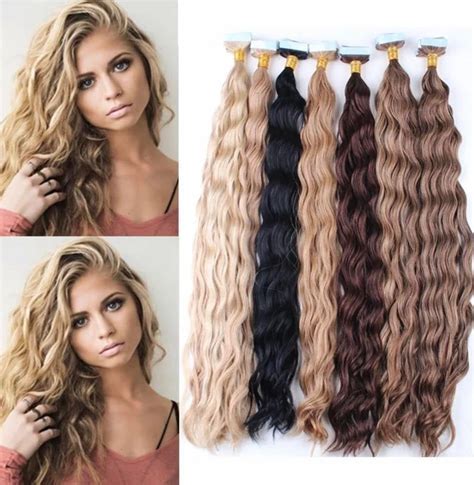Introduction
Synthetic hair extensions have become increasingly popular in the beauty industry, offering a versatile and affordable way to transform one’s appearance. With an estimated global market size of $50 billion, it’s no wonder that synthetic hair extensions are gaining traction among beauty enthusiasts and professionals alike.

Benefits of Synthetic Hair Extensions
Synthetic hair extensions offer several advantages over natural hair extensions:
- Affordability: Synthetic hair extensions are significantly cheaper than natural hair extensions, making them a more accessible option for many.
- Durability: Synthetic hair is more resistant to heat, chemicals, and moisture, making it less prone to damage than natural hair.
- Variety: Synthetic hair extensions come in a wide range of colors, textures, and lengths, providing endless styling possibilities.
- Low Maintenance: Synthetic hair extensions require minimal maintenance compared to natural hair extensions. They can be washed and styled less frequently.
- Ethical Considerations: Unlike natural hair extensions, synthetic hair does not involve the exploitation of human donors.
Types of Synthetic Hair Extensions
There are several types of synthetic hair extensions available, each with its own unique characteristics:
- Kanekalon: Kanekalon is a high-quality synthetic fiber that mimics the look and feel of natural hair. It is often used for braiding and weaving.
- Acrylic: Acrylic is a budget-friendly synthetic fiber that is less durable than Kanekalon. It is suitable for temporary use.
- Polypropylene: Polypropylene is a lightweight and heat-resistant synthetic fiber that is often used for clip-in extensions.
- Nylon: Nylon is a strong and durable synthetic fiber that is used for a variety of extension types, including tape-ins and wefts.
Choosing the Right Synthetic Hair Extensions
Choosing the right synthetic hair extensions depends on several factors, including:
- Desired Style: Consider the type of style you are trying to achieve, such as volume, length, or color enhancement.
- Hair Type: Match the texture and color of the synthetic hair extensions to your natural hair.
- Budget: Determine the amount you are willing to spend on synthetic hair extensions.
- Maintenance Level: Select synthetic hair extensions that require the level of maintenance you are willing to commit to.
Applying and Removing Synthetic Hair Extensions
Applying and removing synthetic hair extensions should be done by a professional hair stylist to ensure proper installation and removal. There are different methods for applying synthetic hair extensions, including:
- Clip-ins: Clip-in extensions are attached to small sections of hair using clips. They are easy to apply and remove, making them a convenient option for temporary wear.
- Weaves: Wefts are rows of hair sewn onto a track that is attached to the natural hair. They are more permanent than clip-in extensions but require professional installation and removal.
- Tape-ins: Tape-in extensions are attached to the natural hair using small adhesive tapes. They are less visible than wefts but may require more frequent maintenance.
Pros and Cons of Synthetic Hair Extensions
Pros:
- Affordable
- Durable
- Variety of options
- Low maintenance
- Ethical considerations
Cons:
- Not as natural-looking as natural hair extensions
- Can be uncomfortable to wear for extended periods
- May require special care products
Customer Testimonials
“I love my synthetic hair extensions! They have given me the volume and length I’ve always wanted.” – Sarah B.
“I’m so glad I chose synthetic hair extensions over natural hair extensions. They are much more affordable and easier to maintain.” – Jessica P.
Frequently Asked Questions
- Q: How long do synthetic hair extensions last?
- A: Synthetic hair extensions can last up to 6 months with proper care.
- Q: Can I color synthetic hair extensions?
- A: No, synthetic hair extensions cannot be colored chemically.
- Q: How do I care for synthetic hair extensions?
- A: Wash synthetic hair extensions with cold water and mild shampoo. Avoid using heat styling tools on high settings.
Strategies for Enhancing the Experience
- Use a detangling brush: Regularly brush synthetic hair extensions with a wide-tooth comb to prevent tangles.
- Store properly: When not in use, store synthetic hair extensions in a cool, dry place.
- Avoid excessive heat: Keep synthetic hair extensions away from heat sources, such as hair dryers and curling irons.
- Use special care products: Invest in hair care products specifically designed for synthetic hair extensions.
- Consult a professional: If you have any questions or concerns, consult a professional hair stylist for guidance.
Conclusion
Synthetic hair extensions are a versatile and affordable option for enhancing one’s appearance. By choosing the right type of extensions and following the proper care instructions, you can transform your look and gain increased confidence in yourself.
Table 1: Types of Synthetic Hair Extensions
| Type | Characteristics |
|---|---|
| Kanekalon | High-quality, mimics natural hair |
| Acrylic | Budget-friendly, less durable |
| Polypropylene | Lightweight, heat-resistant |
| Nylon | Strong, durable |
Table 2: Methods for Applying Synthetic Hair Extensions
| Method | Description |
|---|---|
| Clip-ins | Attached using clips |
| Weaves | Sewn onto a track |
| Tape-ins | Attached using adhesive tapes |
Table 3: Pros and Cons of Synthetic Hair Extensions
| Pros | Cons |
|---|---|
| Affordable | Not as natural-looking as natural hair extensions |
| Durable | Can be uncomfortable to wear for extended periods |
| Variety of options | May require special care products |
| Low maintenance | |
| Ethical considerations |
Table 4: Strategies for Enhancing the Experience
| Strategy | Description |
|---|---|
| Use a detangling brush | Prevents tangles |
| Store properly | Keep extensions in a cool, dry place |
| Avoid excessive heat | Protect extensions from heat damage |
| Use special care products | Invest in products for synthetic hair |
| Consult a professional | Seek guidance for questions or concerns |
